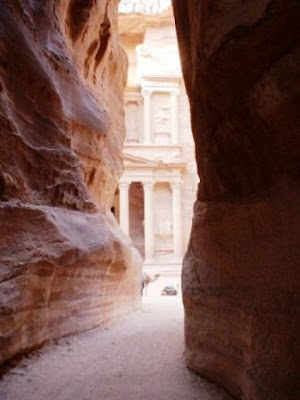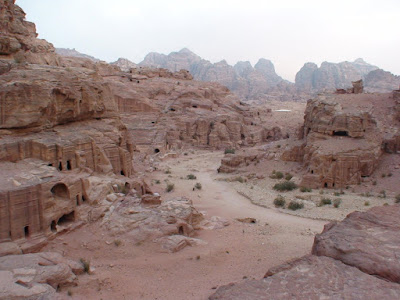The movies, we are told, imitate life, but in parts of Jordan, life imitates the movies! Take the Treasury in the ancient Nabatean city of Petra. Why, everyone immediately recognizes it from the opening scenes of Indiana Jones and the Last Crusade. Or what about Wadi Rum? Why that is pure Lawrence of Arabia! In the mind’s eye, we have “been there, seen that” and marvelled at the mystery and the grandeur, but like the many colas on the market, “The real thing” is so much better, because instead of a glimpse, it gives perspective, and in a country of many treasures, the fabled trading town of Petra, which was only ‘re-discovered’ at the turn of the Eighteenth Century, and the majesty of vista that is Wadi Rum, are global treasures as well.
We arrived in Petra just as the sun was setting and a cold wind sprang into the clear night. The moon came up full, like an on-going flair, a creamy yellowish texture like a runny Camembert. In the warmth of our hotel room, my wife was reluctant to don her thermals, Czarina hat, and warm gloves, but the splendour of the occasion drove her on like a reluctant Scott. With about two hundred other souls, we followed a trail of thousands of candles, set in brown paper bags to ward off any wind, and made the thirty minute walk down the narrow entrance Siq, to marvel at the Treasury in the moonlight. In essence, the trail of lights was unnecessary in the candle-power of the moonlight, but the Hansel and Gretel trail did look decidedly romantic, and was rather helpful in those parts of the Siq where the huge and original Roman flagstones still form the narrow walkway. While they are fine for chariots, their slightly differing levels, are a real test for trainers in the moonlight! At the end of the Siq, we just stood slack-mouthed, and gazed at the Treasury, naked but for moonlight, and while we drank rose-tea, Arabic music and later the words of a recitation spilled from the dark interior of the building. It was mystical, magical, haunting and in some ways, almost pagan, but decidedly memorable.
The Siq is as though some-one took a piece of honeycomb, snapped it in two, and then put it together again leaving a millimetre crack in between the two. Now think of the honeycomb as being 200 metres high in parts, with an original entrance arch of carved stone, a mini aqueduct carved into one side of the passage to bring water for irrigation and animals, and on the other side a ceramic pipe that similarly twists and turns for 1.2 kilometres to provide water for humans. Now take it back to the 6th Century, BC and you have the entrance portal to the city of Petra which flourished as a Nabatean trading place for five hundred years, on the great trade route from Cairo and Arabia to Damascus. Like the Egyptians, the Nabateans believed in the afterlife, but instead of building pyramids, they, carved huge tombs into the sandstone and the wealthier the person, the grander and richer the tomb. Oh all the usual suspects held tenancy, Romans, those folks from Byzantium, and until 1189, the Muslim forces of Saladin, but after that it was largely abandoned and forgotten. Then, in 1812, after an overture to the locals, who were happily and secretly extracting booty from the Nabatean tombs, a la the chaps in Egypt, a Swiss scholar, Jean Louis Burckhart, disguised in local garb as a Muslim holy man (albeit as a rather Pale Rider), rode through the Siq, and simply couldn’t contain his wonder. Apres Burckhart les deluge, and since that time, the fascination with the “Arabic Orient” has ensured a stream of archaeologists and commercial gold-diggers. In 1984, the Jordanian Government moved out into a new and nearby village, the Bedouin tribes-folk living in Petra and declared it a Heritage site. Those Bedouins come back every day as guides and stall-holders to draw benefit from the site, and no longer do their tomb-robbing – well so we were told! When Petra was declared a UNESCO World Heritage Site, more money was made available for excavation, and new discoveries are being made, as you read! But thanks to Indy, that truly unforgettable ‘first glimpse’ of the Treasury, is known to everyone.

The Treasury at the end of the Siq
The next morning we came again with a guide, an ophthamologist whose work as an opthamologist realises 1500 Jordanian Dinar a month, while as a guide is 5000 Jordanian Dinar a month! Alas, it says much about ‘the system’ in Jordan when looking at the relative costs of training a doctor, and a guide! He showed us camel carvings in the stone to signify the trade route, the high alters and shrines, an amphitheatre and the site of the majestic Royal tombs, and told us tales of long ago, because the Nabateans had carved so much in Greek, that can still be easily read today. The place was alive with tourists and their totem-toting guides, people flogging horse and donkey-rides, camelteers too, tourism on the trot. There were too, lots of stalls selling the fine Petra sand in a bottle with your name ‘stencilled’ on the inside, in black sand, assorted stalls all selling the same tack, and humpy-style tea and coffee shops. There was too a make believe Nabatean settlement full of authentic re-enactment actors, their fires and their beasts. No, better to see Petra in its night time silence, or while the hordes are still sleeping, or lurching over the breakfast buffet!

The Treasury in the early morning, and not a soul to be seen! Just ghosts!
But the Treasury is the jewel in the crown and indeed, the Bedouin rifle shots at the carved crown above the Treasury, showed that they thought the Pharaohic-type tomb really held treasure, and sought to 'break it open'. The Treasury was probably another regal tomb, but is today guarded by the magnificently attired soldiers, in red and white Arab head-cloth, khaki tunics and skirt, and with a dagger in their Sam Brownes. The boys in blue, two by two, patrol on horseback, their Pikelhaube head-dress with neck protection, make them look like a mix between a WWI Prussian and Beau Geste! The clip-clop of their horses in the Siq is really spine tingling.

Petra dawn, on the way to the Place of High Sacrifice
The next morning, at 6.00am, with the moon hung low in a sling of clouds, I was the first into the site. The cooing of the doves in the Siq sounded eerily like the call of ghosts and with tombs so nearby, I was certain that they were watching me. In 400 BC, 20,000 people had lived in the valley, and surely some spirits were still around. I climbed a veritable Jacob's Ladder to the Place of High Sacrifice, my thighs trembling, my knees aching, upward, ever upward, till the trail petered out in a sandy upland. In the rarefied oxygen, my brain had missed a turn, and I really wondered as I wandered, slightly lost, whether I would be sacrificed on high as the contents of my plastic water bottle rapidly diminished. Like Bartholemeo Diaz, I turned back disappointed having failed to find my place of good hope, but when I found the trail on my way back, I felt instinctively like Vasco de Gama! When I got back to the bottom, I ate the bonbon which I squirreled away to sustain me till I was found! My reward for my endeavours, was to see the Treasury spotlighted by the sun. It was really worth the sacrifice.
Winfred Peppinck is the Tales of the Traveling Editor for Wandering Educators.
